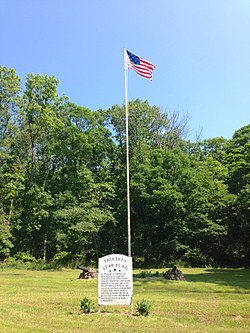
The Continental Army was the army of the Thirteen Colonies and the Revolutionary-era United States. It was formed by the Second Continental Congress after the outbreak of the American Revolutionary War, and was established by a resolution of Congress on June 14, 1775. The Continental Army was created to coordinate military efforts of the Colonies in their war for independence against the British, who sought to keep their American lands under control. General George Washington was the commander-in-chief of the army throughout the war.
Pluckemin is an unincorporated community located within Bedminster Township, in Somerset County, New Jersey, United States. It was also known historically as Pluckamin. It was the site of several historic events during the American Revolutionary War.

The Battle of Bound Brook was a surprise attack conducted by British and Hessian forces against a Continental Army outpost at Bound Brook, New Jersey during the American Revolutionary War. The British objective of capturing the entire garrison was not met, although prisoners were taken. The U.S. commander, Major General Benjamin Lincoln, left in great haste, abandoning papers and personal effects.
Martinsville is an unincorporated community and census-designated place (CDP) located within Bridgewater Township, in Somerset County, New Jersey, United States. As of the 2010 United States Census, the CDP's population was 11,980.
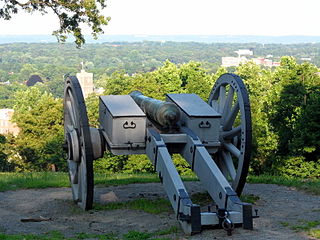
Fort Nonsense is one of four sites comprising the Morristown National Historical Park, in Morristown, Morris County, New Jersey, United States. Two other sites in Morris County are the Ford Mansion and Jockey Hollow. The fourth is the New Jersey Brigade Encampment Site in Bernardsville, Somerset County.

As the location of many major battles, New Jersey was pivotal in the American Revolution and the ultimate victory of the American colonists. This important role earned it the title of Crossroads of the American Revolution.
The 2nd New Jersey Regiment was raised, on 9 October 1775, at Trenton, New Jersey, for service with the Continental Army under the command of Colonel William Maxwell. The regiment would see action at the Battle of Trois-Rivières, Battle of Valcour Island, Battle of Brandywine, Battle of Germantown, Battle of Crooked Billet, Battle of Monmouth, Sullivan Expedition, Battle of Springfield and the Battle of Yorktown. The regiment was furloughed, on 6 June 1783, at Newburgh, New York, and disbanded 3 November 1783.

The Wallace House is a Georgian style historic house, which served as the headquarters of General George Washington during the second Middlebrook encampment (1778–79), located at 38 Washington Place, Somerville, Somerset County, New Jersey, United States. It was added to the National Register of Historic Places on December 2, 1970.
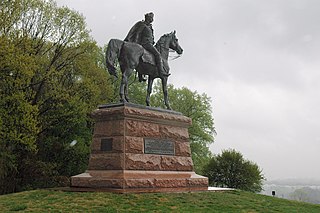
The Philadelphia campaign (1777–1778) was a British effort in the American Revolutionary War to gain control of Philadelphia, which was then the seat of the Second Continental Congress. British General William Howe, after failing to draw the Continental Army under General George Washington into a battle in northern New Jersey, embarked his army on transports, and landed them at the northern end of Chesapeake Bay. From there, he advanced northward toward Philadelphia. Washington prepared defenses against Howe's movements at Brandywine Creek, but was flanked and beaten back in the Battle of Brandywine on September 11, 1777. After further skirmishes and maneuvers, Howe entered and occupied Philadelphia. Washington then unsuccessfully attacked one of Howe's garrisons at Germantown before retreating to Valley Forge for the winter.

The Somerset Hills is known as the northern region of Somerset County located in the U.S. state of New Jersey and includes the municipalities of Bedminster, Bernardsville, Bernards Township, Far Hills, Peapack & Gladstone. The Morris County communities of the Chesters and the Mendhams are often considered part of the Somerset Hills.
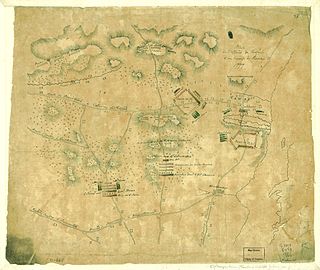
The Battle of Short Hills was a conflict between a Continental Army force commanded by Brigadier General William Alexander, and an opposing British force commanded by Lieutenant General William Howe. The battle took place on June 26, 1777, at Scotch Plains and Edison, New Jersey, during the American Revolutionary War.

Valley Forge functioned as the third of eight winter encampments for the Continental Army's main body, commanded by General George Washington, during the American Revolutionary War. In September 1777, Congress fled Philadelphia to escape the British capture of the city. After failing to retake Philadelphia, Washington led his 12,000-man army into winter quarters at Valley Forge, located approximately 18 miles (29 km) northwest of Philadelphia. They remained there for six months, from December 19, 1777 to June 19, 1778. At Valley Forge, the Continentals struggled to manage a disastrous supply crisis while retraining and reorganizing their units. About 1,700 to 2,000 soldiers died from disease, possibly exacerbated by malnutrition.

Middlebrook is an unincorporated community within the borough of Bound Brook in Somerset County, New Jersey. It is named after the Middle Brook, a tributary of the Raritan River, on the western side of the community. The early-18th-century Old York Road, connecting Philadelphia to New York City, passed through here.

Washington Valley Park is a 715-acre (2.89 km2) public park between the first and second Watchung mountain ridge in the Martinsville section of Bridgewater Township, New Jersey that is administered by the Somerset County Park Commission. It contains the Washington Valley Reservoir and the Chimney Rock Hawk Watch.

Middle Brook is a tributary of the Raritan River in Somerset County, New Jersey. The stream can be referred to as Rha-weigh-weiros, a Native American name meaning "running from a deep hole", on early maps of the area.

The Jacobus Vanderveer House, also known as Knox House, is a U.S. Federal style house located just north of the community of Pluckemin in Bedminster Township, Somerset County, New Jersey at the junction of US 202 and 206 north of River Road. The house was added to the National Register of Historic Places on September 29, 1995, and noted as an "excellent example of a Dutch–American house". The Vanderveer /Knox House & Museum while owned by Bedminster Township, is operated under the direction of the Friends of the Jacobus Vanderveer House, a 501-C3 non-profit organization. The Jacobus Vanderveer House is situated on part of the 218 acres (0.88 km2) that make up River Road Park. The house was thought to be built somewhere in the mid-1770s by James (Jacobus) Vanderveer, son to Jacobus Vanderveer after the property was willed to him by his father.
The Pluckemin Continental Artillery Cantonment Site in Pluckemin, New Jersey, at the southern section of Bedminster Township, New Jersey, holds historic American Revolutionary War importance as the Continental Army's artillery winter cantonment during the winter of 1778–79. It was nestled on the western side of the Second Watchung Mountain just to the North of the village of Pluckemin. The major significance of the site lies with the very different picture it yields of military organization during the Revolutionary War, although some point to it as the birthplace of the American military academy, 24 years prior to the founding of the United States Military Academy at West Point.

The Staats House, also known as the General Baron von Steuben Headquarters, is a historic building located at 17 Von Steuben Lane in South Bound Brook, Somerset County, New Jersey. Constructed c. 1740, it is now known as the Abraham Staats House after its second owner. In 1779, during the second Middlebrook encampment of the American Revolutionary War, it served as the headquarters for Prussian-American General Friedrich Wilhelm von Steuben. The house was added to the National Register of Historic Places on December 4, 2002, and noted as representing "one of the finest remaining buildings from the second phase of Dutch immigration and settlement in the Raritan Valley".
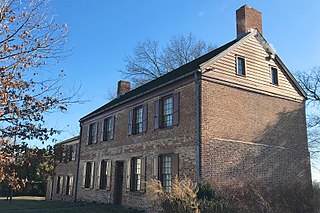
The Van Veghten House is a historic building in the Finderne section of Bridgewater Township, New Jersey, United States. The house was built c. 1725 and served as the headquarters of Quartermaster General Nathanael Greene during the second Middlebrook encampment (1778–79) in the American Revolutionary War. The Somerset County Historical Society owns the house and uses it as its headquarters, including a museum and library. The early-18th-century Old York Road, connecting Philadelphia to New York City, passed by here. The house was added to the National Register of Historic Places on October 10, 1979, and noted as representing "one of the few remaining Raritan River mansions".

The Van Horne House is a historic building at 941 East Main Street near Bound Brook in Bridgewater Township, Somerset County, New Jersey. The house was built c. 1750 and also known as Phil's Hill, after its owner, Philip Van Horne. It served as the headquarters for American General Benjamin Lincoln in 1777, during the American Revolutionary War, in particular the Battle of Bound Brook. Later, it served as the headquarters for American General William Alexander, Lord Stirling during the second Middlebrook encampment (1778–79). The house, on the early-18th-century Old York Road that connected Philadelphia to New York City, was a New Jersey landmark during the war. Since 2002, the Heritage Trail Association has used the house as its headquarters, including an exhibit space. It was added to the National Register of Historic Places on March 8, 2002, for its locally significant Colonial Revival architecture from 1937 to 1944.
